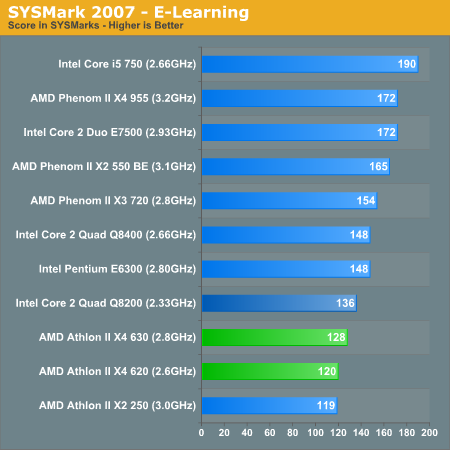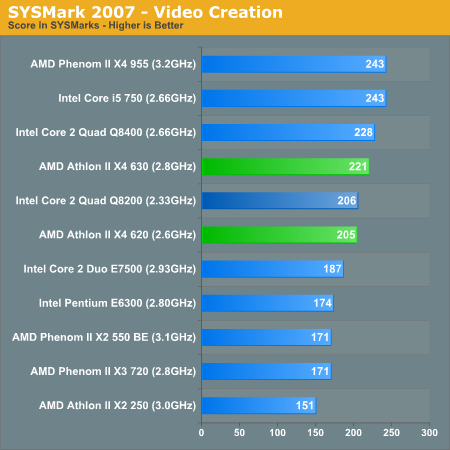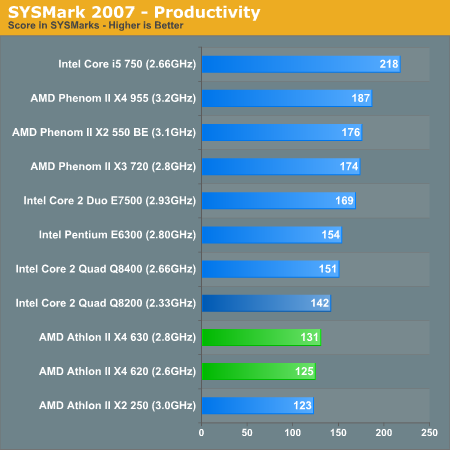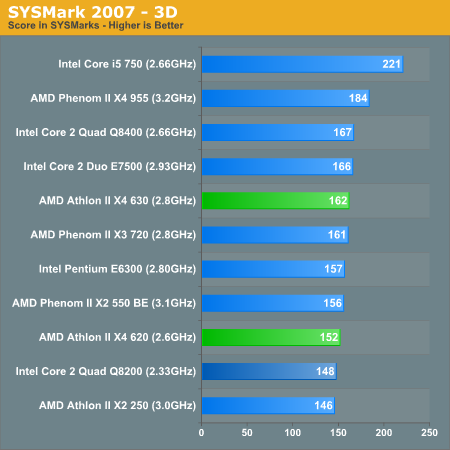AMD Athlon II X4 620 & 630: The First $99 Quad Core CPU
by Anand Lal Shimpi on September 16, 2009 12:00 AM EST- Posted in
- CPUs
SYSMark 2007 Performance
Our journey starts with SYSMark 2007, the only all-encompassing performance suite in our review today. The idea here is simple: one benchmark to indicate the overall performance of your machine.

If we only look at the AMD numbers in this chart, there's a pretty nice lineup going on here. The Athlon II X2 250 is slower than the Athlon II X4 620/630, which is slower than the Phenom II X3 730 and all are slower than the Phenom II X4 955. The performance lines up with the pricing, so all is good.
The problem with these cheap quad-cores has always been that you give up a lot in order to get four cores at a low price. The Athlon II X4 appears to break the mold however. The Athlon II X4 620 is priced at $99 and it performs like a $99 CPU. With the exception of the Core 2 Duo E7500 whose high clock speed makes it do unsually well here, the 620 is balanced. You get a reasonably high clock speed and enough cache to be competitive, both at a good price.
You'll see in the individual tests below that performance varies between competitive and underwhelming depending on the task. Anything that can take advantage of four cores does well, otherwise the smaller L2s of the Athlon II X4 hurt it a bit.

In applications that aren't well threaded, you'll see the Athlon II X4 perform less than stellar - but the same is true for all lower end quad-core CPUs. Even the Q8200 is outperformed by the E6300 here. Situations like this are validation for Intel's aggressive turbo modes on Lynnfield.

Any strenuous video encoding however will seriously favor the Athlon II X4. Here we find the $99 620 tying the Core 2 Quad Q8200, and the 630 outperforming it - all at a lower price.

We're back to needing higher clock speeds and larger caches to compete. Being a quad-core processor isn't easy.











150 Comments
View All Comments
Chlorus - Wednesday, September 16, 2009 - link
He posted right after me...I'm kinda wondering if we should setup a drinking game or something each time he posts.strikeback03 - Wednesday, September 16, 2009 - link
Good idea, and everyone drinks when you spot a new alias.deputc26 - Wednesday, September 16, 2009 - link
I would absolutely love to see a die size comparison. That will give real information on how this chip can make AMD $$.Lokinhow - Wednesday, September 16, 2009 - link
there is a die size comparsion on the first page..P2 X4 = 258 mm2
A2 X4 = 169 mm2
A2 X2 = 117 mm2
C2Q 8xxx = 164 mm2
deputc26 - Wednesday, September 16, 2009 - link
Apparently I'm a moron. Don't know how I missed that unless it was added after initial publication as I read it right after it came out.Eeqmcsq - Wednesday, September 16, 2009 - link
Anand, how did you know whether or not your Athlon II X4s are harvested Denebs?Also, any idea why the Athon II X4s debut at such a high TDP with no L3? I'd think they'd be lower at 65w or at least 80w.
AMD, $100 quad cores is nice... BUT... where's the 45w quads???
Lokinhow - Wednesday, September 16, 2009 - link
I may be wrong, but..I think the high TDP is because we have both Propus and Deneb-Harvested Cores
The Athlon II based on Deneb probably have this 95W TDP, while the ones based on propus core have lower TDP.
I think they have only a few propus core to sell, so that's why they are selling harvesteds Denebs. When there wil have only Athlons II X4 propous based they'll rate it with a lower TDP.
Makes sense?
Spoelie - Wednesday, September 16, 2009 - link
Yes and noIt's a bit strange that the deneb die (630) consumes less power than the propus die (620) in idle if that theory was valid. During load the difference is just as much as the difference in clock speed would indicate. So if the 630 is indeed a deneb (care to rip the IHS of? ;)) then this means that propus is not by definition less power hungry than deneb.
Anand Lal Shimpi - Wednesday, September 16, 2009 - link
AMD specifically told us that our 620s are Propus samples, but that others may be Denebs. I'm not sure how to tell if you have a harvested Deneb just yet.Give AMD some time, I'm sure we'll see them down below 95W as the process matures for these dice.
Take care,
Anand
TA152H - Wednesday, September 16, 2009 - link
Anand,A couple of things. You mentioned the 'small' L2 cache being a problem on one of your benchmarks, but, it's actually twice as large as the one on the Phenom. I'm not sure if this was meant to be a comparison only with the Penryns, but it's a bit confusing.
Also, going back to the L2 cache, how can these possibly be harvested from Phenoms with a bad L3 cache. That would imply the Phenoms are built with 512K L2 cache, with half of it disabled. I really doubt this is the case. You CAN remove the L3, but how do they then double the L2 cache? This seems strange to me.
Based on the relatively poor overclocking potential of this chip, would you attribute that to the L2 cache? Does the L2 cache run with the same number of wait states as that of the Phenom? If so, that could prove to be the main reason for the lower overclocking potential. Any ideas on this?
Also, don't you think it's worth mentioning AMD's greatly superior IGPs, considering this product could easily find it's way in this platform rather often. The processor by itself does make sense, but, even if it didn't, the superior IGP platform still can make AMD processors somewhat attractive.